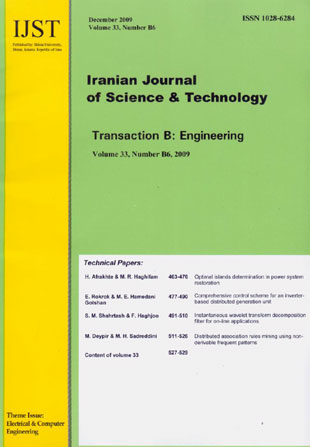فهرست مطالب

Iranian Journal of science and Technology (B: Engineering)
Volume:33 Issue: 6, Dec2009
- Electrical & Computer Engineering
- 70 صفحه،
- تاریخ انتشار: 1388/11/10
- تعداد عناوین: 5
-
-
Pages 463-476In this paper, the effect of the islands number variation in the restoration process is investigated and a method to determine optimum island boundaries is presented. Also, the impact of Parallel Reactive Power Sources (PRPS) on the number and boundaries of each island and restoration process is studied. In the optimization process, the objective function is minimizing Energy Not Supplied (ENS) and constraints are voltage margins in buses, transmission lines capacities and generators loading limits. The ENS is evaluated based on generation capacity allocation to demand loads method. Genetic algorithm (GA) is the base of optimization and an appropriate chromosome coding is developed for the network modeling. In order to assess the capabilities of the proposed method, the IEEE-118 bus network has been used as the test system. The results of sectionalizing the test system to 2 to 7 islands with optimum boundaries have been given in case studies.
-
Pages 477-490In this paper, a complete control scheme is developed for an inverter-based distributed generation (IBDG) unit to produce high quality AC voltages in unit terminals. The unit uses a three-phase, four-leg inverter. The control scheme includes a feed-forward current control path and two nested loops, the outer loop for regulating the DG output voltage and the inner one for controlling the inverter current. Proportional-Resonant (PR) controllers are used in the voltage loop to track a sinusoidal reference voltage and eliminate low-order voltage harmonics. The inner current loop is used for over-load protection of the inverter, and improvement of the control system response. The current controller is designed by the state feedback method. The feed forward current control path is used to reduce impacts of load disturbances on the IBDG output voltages. Regarding the role of the inverter output filter and controllers in voltage quality, the filter design procedure is reviewed, the approach to choosing the controllers parameters is explained, and stability conditions of the system are investigated. The performance of an IBDG that supplies a local load is studied under unbalanced and nonlinear loading, and sudden changes in the load amount and voltage amplitude.
-
Pages 491-510In this paper, a new digital filter in the category of parallel implemented Wavelet Transform Decomposition (WTD) is proposed for on-line applications. The presented method allows a faster filtering process, even if one considers calculation with every newly drawn sample, and the successive procedure of signal processing in basic Discrete Wavelet Transform (DWT) is omitted. The most important feature of this filter is its reduced order form. Although it gives an approximated filter, its output has a good agreement with full order form and deliberately offers less delay and calculation burden to give the outputs.
-
Pages 511-526Mining association rules in distributed databases is an interesting problem in the context of parallel and distributed data mining. A number of approaches have, so far, been proposed for distributed mining of association rules. However, most of them consider all types of frequent itemsets the same, even though there are different types of itemsets in distributed databases, e.g., derivable and non-derivable. In this study, a new application of deduction rules is introduced for distributed mining of association rules which exploits the derivability of itemsets to reduce communication overhead and to enhance response time. A new algorithm is proposed which mines derivable and non-derivable frequent itemsets in a distributed database. Since the collection of derivable and non-derivable frequent itemsets form all frequent itemsets, our algorithm mines all frequent itemsets rather than a subset of them. In the algorithm, there is no need to scan local databases and exchange messages in order to obtain support counts of derivable frequent itemsets, since each site can produce them autonomously. Experimental evaluations on horizontally partitioned real-life datasets show that such exploitation drastically reduces communication and also improves response time. Therefore the new algorithm is useful when communication bandwidth is the main bottleneck.
-
Content of volume 33Pages 527-529

